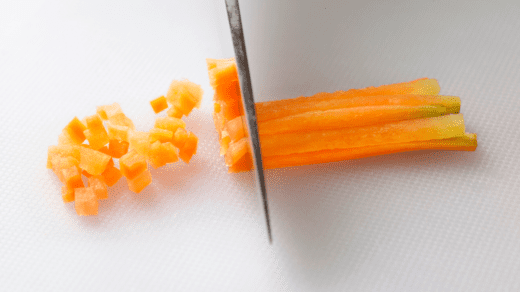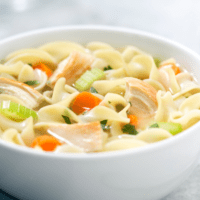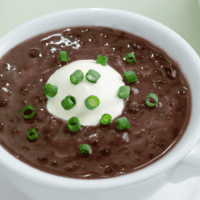Hey There! Some links on this page are affiliate links, which means that as an Amazon Associate, I may earn a small commission at no extra cost to you. I greatly appreciate your support! Learn more on my Affiliate Disclosure page.
When it comes to cooking, fresh herbs can elevate your dishes from good to gourmet. In this informative blog post, “How to Chop Rosemary and Thyme: A Step-by-Step Guide,” we’ll walk you through the process of chopping these aromatic herbs.
Whether you’re a seasoned chef or a home cook, knowing how to properly chop rosemary and thyme can enhance the flavor and presentation of your meals. Let’s dive into the essential tools and techniques to get the most out of your fresh herbs.
Why You Will Love This Guide

Using freshly chopped herbs like rosemary and thyme can significantly enhance the taste and aroma of your dishes. These herbs are incredibly versatile, perfect for everything from roasted meats and vegetables to soups and stews.
Plus, chopping your herbs correctly ensures you get the most flavor from each sprig. The table below outlines the key benefits of using freshly chopped rosemary and thyme in your cooking:
| Benefit | Description | Examples | Additional Notes |
|---|---|---|---|
| Enhanced Taste and Aroma | Freshly chopped rosemary and thyme release essential oils that enhance the overall flavor and aroma of dishes. | Roasted meats, grilled vegetables, soups, and stews. | Fresh herbs provide a more intense and vibrant flavor compared to dried herbs. |
| Versatility | These herbs can be used in a wide variety of dishes, making them a staple in many cuisines. | Roasted meats, vegetables, soups, stews, marinades, and dressings. | Both herbs complement various ingredients, adding depth and complexity to dishes. |
| Optimal Flavor Extraction | Correct chopping techniques ensure that the herbs are evenly distributed throughout the dish, maximizing flavor release. | Finely chopped herbs can be added to sauces, rubs, and garnishes. | Using a sharp knife and proper chopping technique prevents bruising and maintains the herbs’ flavor integrity. |
Essential Tools for Chopping Herbs

Before diving into the chopping process, gathering the essential tools you’ll need is important. Having the right tools not only makes the job easier but also ensures that your herbs are chopped correctly, maximizing their flavor and aroma. Here are the key tools and their benefits:
| Tool | Description | Benefits |
|---|---|---|
| Sharp Chef’s Knife | A sharp knife ensures clean cuts and minimizes bruising. | Clean cuts preserve the herbs’ essential oils, enhancing flavor. |
| Cutting Board | A sturdy surface to chop your herbs. | Provides a stable and safe area for chopping. |
| Kitchen Scissors (optional) | Useful for trimming stems. | It makes it easier to remove tough or woody stems. |
| Herb Stripper (optional) | It makes removing leaves from stems easier. | Saves time and effort, especially with herbs like rosemary and thyme. |
| Kitchen Towel | Useful for drying herbs after washing, as well as keeping the work area clean. | Ensures herbs are dry before chopping, preventing them from becoming mushy. |
How to Chop Rosemary and Thyme – VIDEO
Step-by-Step Guide to Chopping Rosemary

Introduction to Rosemary: Rosemary is a fragrant herb with needle-like leaves. Its robust flavor pairs well with meats, especially lamb and poultry.
Steps to Chop Rosemary:
- Wash and Dry: Rinse the rosemary under cold water and pat dry with a paper towel.
- Remove Leaves: Hold the top of the stem with one hand and strip the leaves off by running your fingers down the stem.
- Gather Leaves: Collect the stripped leaves into a small pile.
- Chop Finely: Using a rocking motion with your knife, chop the leaves into fine pieces. Continue until the desired consistency is reached.
Tips:
- Use a sharp knife to avoid bruising the leaves.
- For a finer chop, go over the leaves a second time.
Step-by-Step Guide to Chopping Thyme

Introduction to Thyme: Thyme is a delicate herb with small, aromatic leaves. It’s commonly used in French and Mediterranean cuisines.
Steps to Chop Thyme:
- Wash and Dry: Rinse the thyme under cold water and gently pat dry.
- Remove Leaves: Hold the top of the stem and slide your fingers down to strip the leaves off.
- Chop Leaves: Gather the leaves and chop them finely with a sharp knife, using a rocking motion.
Tips:
- You can chop the stems with the leaves if they are tender.
- Ensure the leaves are dry before chopping to prevent clumping.
Common Mistakes to Avoid

Chopping herbs might seem straightforward, but there are a few common mistakes that can affect the quality and flavor of your herbs. Avoiding these mistakes ensures you get the best results from your freshly chopped rosemary and thyme. Here are the key mistakes to watch out for:
| Mistake | Description | Impact on Herbs |
|---|---|---|
| Using a Dull Knife | This can bruise the herbs and cause them to lose flavor. | Bruised herbs release less flavor and can become discolored. |
| Over-Chopping | This can turn your herbs into a paste rather than finely chopped pieces. | Over-chopped herbs lose their texture and can become mushy. |
| Not Drying Herbs Properly | Wet herbs can become mushy when chopped. | Moisture causes the herbs to clump together and lose their aromatic oils. |
Conclusion

Chopping rosemary and thyme might seem simple, but doing it correctly can make a big difference in your cooking. Now that you know how to chop these herbs properly, you can confidently add them to your dishes for a burst of fresh flavor. Give it a try and see how these techniques elevate your meals!
Ready to enhance your cooking skills? Start chopping some fresh rosemary and thyme today and experience the difference they make! Don’t forget to share your experiences and tips in the comments below. For more culinary tips and recipes, subscribe to our blog and join our cooking community.
Thank you for reading! Be sure to check back soon for more informative and exciting articles.
Happy cooking!
FAQs

Can I use dried rosemary and thyme instead of fresh?
Yes, but fresh herbs provide a more vibrant flavor.
What’s the best way to store fresh rosemary and thyme?
Store in an airtight container in the refrigerator or freeze for long-term storage.
Do I need to remove the stems before chopping?
Yes, removing the stems makes chopping easier and ensures a better texture.
Can I use a food processor to chop herbs?
While possible, a food processor can over-chop herbs, turning them into a paste.
How do I prevent herbs from sticking to the knife?
Ensure the herbs are dry, and use a sharp knife to minimize sticking.
What’s the best knife to use for chopping herbs?
A sharp chef’s knife is ideal for chopping herbs.
Can I chop herbs in advance?
Yes, but chop herbs just before using them for the best flavor.
Hey There! Some links on this page are affiliate links, which means that as an Amazon Associate, I may earn a small commission at no extra cost to you. I greatly appreciate your support! Learn more on my Affiliate Disclosure page.


























